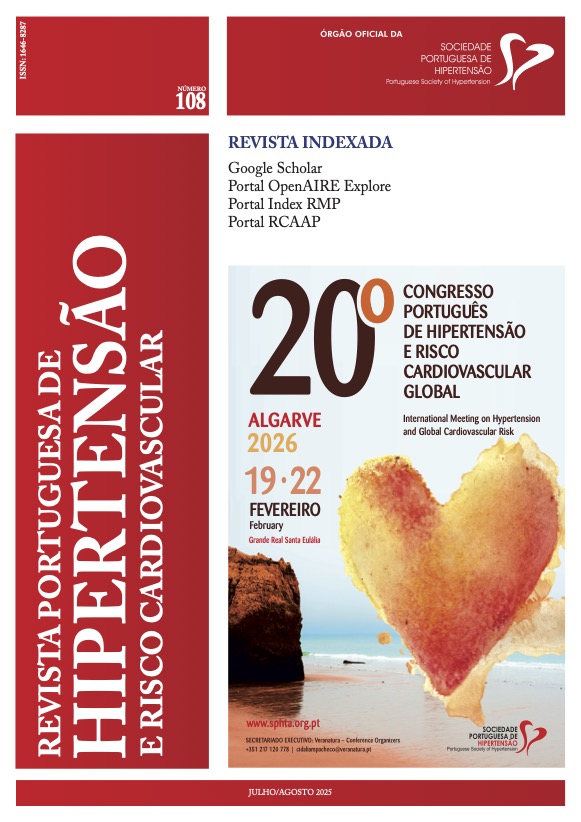CHARACTERIZATION OF HYPERTENSION IN A INTERNAL MEDICINE WARD
DOI:
https://doi.org/10.58043/rphrc.177Keywords:
Hypertension, Elevated blood pressure, Internal Medicine, Hospitalization, ElderyAbstract
Introduction: Arterial hypertension is a serious disease, affecting more than 60% of individuals over 60 years-old. It is associated with the development of cardiac disease, terminal renal failure and cerebral disease, with increased risk of cognitive decline and dementia. The World Health Organization and the European Society of Cardiology forewarn about a low therapeutic compliance and impact, thus being controlled in just 14% of cases. They recommend starting with combined agents in a single pill to increase its compliance and efficacy, lowering adverse effects and minimizing the serious events associated with hypertension.Objectives: Characterize the hypertensive patients in an internal medicine ward; evaluate the applicability of the Hypertension guidelines with combined therapy in the hypertensive patients admitted to an internal medicine ward; identify the main classes prescribed.
Methods: Hypertensive patients admitted in 12 beds in an internal medicine ward during 2021 were identified and characterized on their age, gender, target organ damage (ischemic cardiopathy records, cerebrovascular disease, chronic renal failure, atrial fibrilation, dementia) and antihypertensive class (angiotensin-converting enzyme (ACE) inhibitors [ACEi], angiotensin II receptor blockers [ARBs], calcium channel blockers [CCB], beta blockers or diuretic) at admission and discharge and it was recorded the combined single pill prescribed. Transferred or deceased patients were excluded.
Results: 130 patients were included, of which 53.1% (n=69) were male, with mean age of 82 years. Of these, 82.3% (n=107) had one or more target organ damaged, being heart failure (n=60, 46.2%) and cerebrovascular disease (n=49, 37.7%) the most commonly observed. At admission, 15 patients (11.5%) did not have antihypertensive drugs and 63.1% (n=82) used 2 or more antihypertensive agents. Combined therapy was identified in 42 patients (32.3%), mainly the combination of ARB and diuretic (n=19), ACEi and diuretic (n=8) or ACEi and CCB (n=7). At discharge it was shown that 13.1% (n=17) did not do antihypertensive treatment and 61.5% (n=80) used 2 or more antihypertensive agents. Combined therapy was prescribed in 17.7% (n=23) patients, more frequently ARB and diuretic, ACEi and diuretic and ACEi and CCB (n=13, n=5 e n= 4, respectively) the most commonly used. Only a patient was started on combined therapy (ACEi and CCB).
Conclusion: Contrary to the recommendations, a reduction in the prescription of combined therapy was observed, with suspension of antihypertensive agents in 13.1% of patients. The authors consider the lack of motives for the suspension of the agents as the main limitation to the study. In the elderly, compliance is directly conditioned by several risk factors, such as cognitive alterations, dependency status, multiple pathologies, polymedication, management of their secondary effects and medical interactions. Individualizing and simplifying therapies are essential tools to clinical practice.
Downloads
References
World Health Organization. Global report on hypertension: the race against a silent killer. Geneva: World Health Organization; 2023.
World Health Organization. Guideline for the pharmacological treatment of hypertension in adults. Geneva: World Health Organization; 2021. Licence: CC BY-NC-SA 3.0 IGO.
John William McEvoy, Cian P McCarthy, Rosa Maria Bruno, Sofie Brouwers, Michelle D Canavan, Claudio Ceconi, Ruxandra Maria Christodorescu, Stella S Daskalopoulou, Charles J Ferro, Eva Gerdts, Henner Hanssen, Julie Harris, Lucas Lauder, Richard J McManus, Gerard J Molloy, Kazem Rahimi, Vera Regitz-Zagrosek, Gian Paolo Rossi, Else Charlotte Sandset, Bart Scheenaerts, Jan A Staessen, Izabella Uchmanowicz, Maurizio Volterrani, Rhian M Touyz, ESC Scientific Document Group. 2024 ESC Guidelines for the management of elevated blood pressure and hypertension: Developed by the task force on the management of elevated blood pressure and hypertension of the European Society of Cardiology (ESC) and endorsed by the European Society of Endocrinology (ESE) and the European Stroke Organisation (ESO). European Heart Journal. 2024 Oct 7;45(38):3912–4018. https://doi.org/10.1093/eurheartj/ehae178.
Lee JH, Kim KI, Cho MC. Current status and therapeutic considerations of hypertension in the elderly. Korean J Intern Med. 2019 Jul;34(4):687-695. doi: 10.3904/kjim.2019.196. Epub 2019 Jul 1. PMID: 31272140; PMCID: PMC6610178.
Bilen O, Wenger NK. Hypertension management in older adults. F1000Res. 2020 Aug 19;9:F1000 Faculty Rev-1003. doi: 10.12688/f1000research.20323.1. PMID: 32850119; PMCID: PMC7438964.
Downloads
Published
How to Cite
Issue
Section
License
Copyright (c) 2025 Rodrigo Duarte, Raquel Flores, João Pereira

This work is licensed under a Creative Commons Attribution 4.0 International License.




